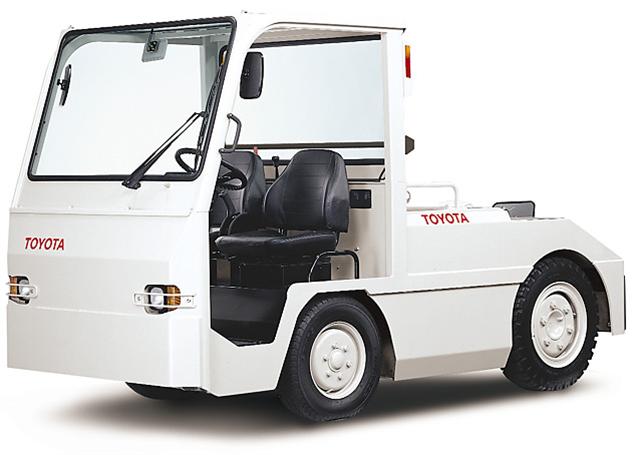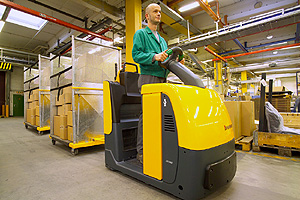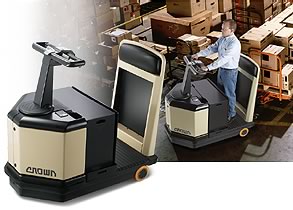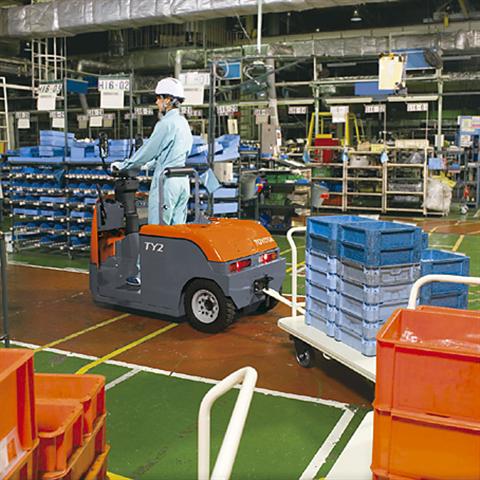 A Toyota tow truck |
Tow trucks, tow tractors, tugs or spotter trucks, as they are variously known, are part of a broad family of small to medium-sized materials handling machines capable of moving weights of up to 80,000kg. They are used worldwide in cargo handling, warehouse distribution centres, product assembly lines, airports, construction sites and hospitals or in any application where a tight turning radius and quiet handling is required.
Tractor operation depends on the size of the machine with models ranging from pedestrian-operated tugs and tows to larger machines where the operator either sits or stands on a platform. Machines are fitted with either towbars or linkage systems for trailers and trolleys.
Tow tractors are manufactured worldwide, but the largest suppliers are in Germany and North America.
Forkliftaction.com has over 1,200 manufacturers and dealers listed on its database, but precise indications of the size of the market are difficult to obtain.
Tow tractor applicationsTow tractors do exactly what their name implies - they tow or pull objects or trailers around a designated area and are usually used in combination with other materials handling equipment.
The most common tow tractor application is at airports, but they are also used extensively in warehousing, ports and production lines where the tow tractor is equipped with linked trailers and sent on a 'milk-run', delivering inventory to work stations, then returning to its starting point for refilling, to start the process again.
They are also ideal for shuttling applications, replacing traditional forklift use with a more time-and labour-efficient system. Toyota marketing executive Nobuhiro Abe cites an example of a compact towing tractor enabling an electrical equipment manufacturer to do away with two forklifts.
"Our customer formerly used three forklifts: one for unloading the parts from a supplier's truck and two for distribution of the parts to the production line," he explains. "By replacing two forklifts for parts distribution operation with one towing tractor, they were able to reduce the (amount) of materials handling equipment, workers and operating space as well as to enhance productivity by the Just-in-Time parts distribution."
Safety and efficiency appear to be two major factors when deciding to use tow tractors. Due to their "lift and carry" design, forklifts often suffer from an obstructed view when carrying loads. Their turnaround time is compromised by their inability to carry more than one load at a time. Tow tractors, meanwhile, tend not to have these types of issues.
 Tow trucks like this Jungheinrich are used for 'milk runs' |
MAFI Industrial Trucks recently helped develop a new cargo tow-trailer transport system for automotive manufacturer DaimlerChrysler, which reduces manpower to one operator and the inventory run to 1.5 hours.
A DaimlerChrysler team leader explains: "Along with safety aspects, which are so important, other parameters had to be taken into consideration. We are seeing a trend to smaller load units here, conversely the supply routes covered are longer. In addition, we wanted to reduce the size of the supply areas to reduce the stocks. Finally, it was also necessary to trolley handling to make it more ergonomic."
Tow trucks aren't often admired for their good looks but they are strong, extremely versatile machines, often able to be customised to the specific application needs of the customer, and because of their ability to be easily modified, are often at the cutting edge of energy efficient technology.
When the new Heathrow T5 terminal opened, British Airways took delivery of a fleet of specially modified Linde P250 baggage tows. Colin McWilliam, general manager ramp services for BA, explains that they needed a model which could carry large and awkwardly shaped luggage.
"We needed to find a model with enough power to navigate some of the inclines around the Terminal 5 campus but still with a commitment to reduce our overall vehicle emissions."
Linde modified the fleet of P250s to include a longer wheelbase platform to accommodate awkward luggage and a twin-axle drive incorporated with a 12kW power output to meet the performance criteria.
It also fitted a 960 copper stretch battery with 25% more energy and longer operating life than the conventional Linde tow tractor battery. By using electric batteries, fuel emission targets were met.
Effect of the global financial crisis on the tow tractor marketLike almost all sectors of the material handling industry, tow tractor sales are not immune to the current global financial crisis (GFC), with decreased activity reported by some manufacturers.
 Crown has a range of tow trucks |
Jose Miguel Romano, commercial director of Spanish tow tractor manufacturer Tecna, notes that for the Spanish economy, the global downturn was the "worst crisis since the Spanish Civil War".
All sectors of Tecna manufacturing, including tow trucks, have seen decreased sales, in some areas of up to 46%, he says.
Linde, Toyota, Jungheinrich and Crown have all admitted experiencing declines of between 20% and 40% in overall materials handling equipment sales for the last financial quarter of 2008. None, however, has revealed which specific sectors have been worst affected.
Observers point out, however, that tow tractor end-users are highly dependent on a healthy automotive, commodities and retail economy, and that these are all sectors badly hit by the GFC. Therefore, tow tractor sales are likely to be adversely affected in the current market conditions.
What's in store for tow tractors - current technology and advancesToday's tow tractors and tugs already include a wide range of innovations.
The Still CX-T series, BT RolatrucTSE3000 and the eTug all use the dead man switch, either incorporated into the standing platform or the seat, to stop the vehicle as soon as the operator alights. This eliminates rollback and possible injury.
 Toyota's 4CBT-20A |
Still and BT models are also fitted with pin code access operation, limiting use to only registered drivers. Other safety features found on many tow tractors are automatic speed reduction systems connected to the braking or steering system. Information about load weight or steering angle is transferred to these systems which cause the tow tractor to automatically slow down when approaching corners.
Ease of manoeuvrability is paramount in tow tractors which are often operating in confined spaces. One example is the BT TSE300's steering system which allows access to the control wheel from either side.
The E-man steering system offers tiller style steering which can be moved to the left or the right sides of the vehicle, to suit the operator and each operation. This allows the operator to walk on either side of the machine while still operating it and to reverse the machine safely from outside the machine.
Both Jungheinrich and Toyota offer models with automatic or semi-automatic remote decoupling devices, decreasing time spent by the operator off the machine and decreasing injury risk by limiting manual intervention.
The most important innovation utilised by tow tractors is energy-efficiency technology, with almost all the leading manufacturers now producing battery electric tow tractor models in response to customer requests for equipment with reduced or zero emissions.
Tadashi Ishikawa, president of the Japanese Industrial Vehicle Association (JIVA), told a recent ITA gathering that electric vehicles now exceed 50% in Japan. This rise applies across all materials handling equipment, but should also indicate an increase in electric tow trucks because he cited expanded warehouse storage space as a key factor.
Electric battery technology has come a long way in the last few years, with batteries now providing longer working hours. They are also more easily stored and regenerate faster.
In another development, Still has been trialling a hydrogen fuel cell in two tugs at Hamburg airport . The R07-25 tow tractor series has the fuel cell installed in the space that normally holds the traction battery. The cell converts the energy contained in the hydrogen, with minimal environmental impact.
Despite concerns about the global downturn, most tow truck manufacturers are still keen to see investment in innovation continue.
Jungheinrich, for example, recently reaffirmed its commitment to R&D investment as part of its strategy to attract customers through these rocky times.
Innovation in ergonomics, energy efficiency, safety and labour-saving devices to increase overall efficiency and reduce downtime through maintenance or injury, all make sense in difficult economic climates.